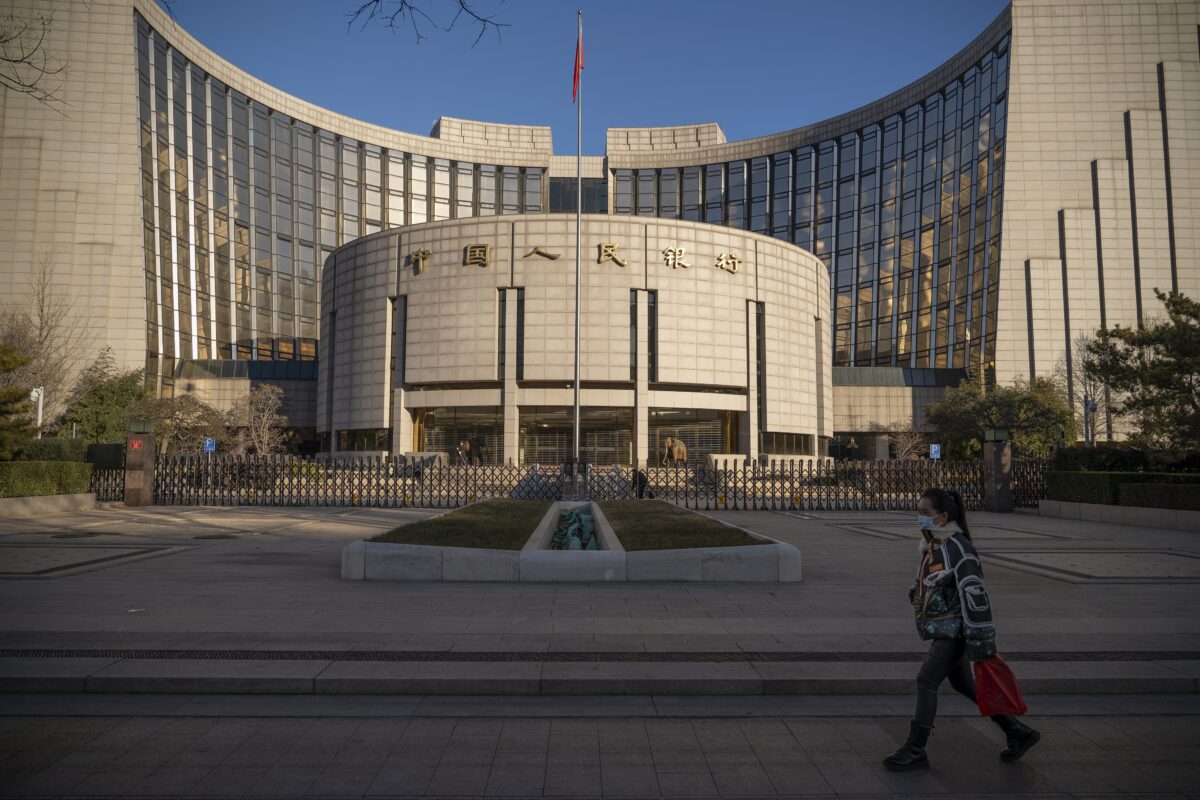What Is the Chinese Communist Party Hiding?
CommentaryA flurry of reports propagating various economic and demographic statistics from communist China have been in the news lately. Is China on the rebound after reversing Chinese leader Xi Jinping’s signature—and failed—zero-COVID policy? Have Chinese economic problems been obfuscated by false numbers from China’s National Bureau of Statistics (NBS) while avoiding the canary in the coal mine, that is, the economic and personal devastation wrought by COVID lockdowns and officially under-reported infections and deaths in recent weeks? Let us try to make sense of recent Chinese statistics and related news reports. Demographics Leading the news is the official report on Jan. 17 that China’s population has shrunk to “roughly 850,000 people for a population of 1.41175 billion in 2022, marking the first decline since 1961, the last year of China’s Great Famine,” as reported by Reuters. The raw numbers are 9.56 million births and 10.41 million deaths in 2022. Predictably, state-run Chinese media focus on fertility rates as the problem “being fixed” by Beijing’s switch from a one-child to a two-child policy and now a three-child policy. From China Daily on Jan. 17, just as the report from the NBS was released: “That China’s population decreased by 850,000 in 2022 is not surprising given that China’s fertility rate has remained lower than the replacement level since 1992.” No worries: the Chinese communists are omniscient and can be trusted to run the country (into the ground)! But what about the other part of the demographics equation? Where do COVID-related deaths factor into the analysis? According to Our World in Data, China’s “pandemic death rate” from COVID-19 has been reported as three deaths per million population since the beginning of the reporting in May 2020. This statistic has been used as a bludgeon by authoritarians worldwide as the reason to emulate Beijing’s zero-COVID policy and enforce (unscientific) lockdowns, mask mandates, and jabs. In contrast, the death rate reported for the United States is 3,251 deaths per million population, while that reported for the European Union is 2,666 deaths per million. People wait for a funeral service for their deceased relatives at Baoxing Funeral Parlor in Shanghai, China, on Jan. 4, 2023. (Wang Gang/VCG via Getty Images) Splitting the difference at 3,000 deaths per million population for China (which is much closer to the true number), the total number of expected Chinese deaths to date due to COVID-19 would be over 3.4 million. These numbers would be consistent with reports of overwhelmed mortuaries in China in recent weeks, the report of 60,000 COVID-related deaths in December, and another report predicting 9,000 deaths per day from the latest wave of COVID variants sweeping through the country. It could well be argued that the population decline in China was perhaps more due to the officially unreported and suppressed number of COVID-related deaths actually sustained. But that will never be officially admitted, as the narrative of the Chinese Communist Party’s (CCP) supposed “world leadership in combatting COVID” would be proven to be as false as the day it was first uttered by Xi and his minions. Economic Statistics What about the myriad of year-end economic statistics from the NBS? What are the numbers hiding? On Jan. 17, China Daily reported that China’s GDP grew by 3 percent in 2022: “GDP growth in the fourth quarter was 2.9 percent year-on-year [which] marked a slowdown from 8.4 percent in 2021.” With the double-whammy of zero-COVID lockdowns and year-end protests and riots that depressed workforce turnout and productivity numbers, can those economic statistics be real? Far better to trust the analysis of independent watchers of the Chinese economy. The Chinese Beige Book posted on Twitter: “Our proxy indicators suggest GDP growth was

Commentary
A flurry of reports propagating various economic and demographic statistics from communist China have been in the news lately. Is China on the rebound after reversing Chinese leader Xi Jinping’s signature—and failed—zero-COVID policy?
Have Chinese economic problems been obfuscated by false numbers from China’s National Bureau of Statistics (NBS) while avoiding the canary in the coal mine, that is, the economic and personal devastation wrought by COVID lockdowns and officially under-reported infections and deaths in recent weeks?
Let us try to make sense of recent Chinese statistics and related news reports.
Demographics
Leading the news is the official report on Jan. 17 that China’s population has shrunk to “roughly 850,000 people for a population of 1.41175 billion in 2022, marking the first decline since 1961, the last year of China’s Great Famine,” as reported by Reuters. The raw numbers are 9.56 million births and 10.41 million deaths in 2022.
Predictably, state-run Chinese media focus on fertility rates as the problem “being fixed” by Beijing’s switch from a one-child to a two-child policy and now a three-child policy. From China Daily on Jan. 17, just as the report from the NBS was released: “That China’s population decreased by 850,000 in 2022 is not surprising given that China’s fertility rate has remained lower than the replacement level since 1992.” No worries: the Chinese communists are omniscient and can be trusted to run the country (into the ground)!
But what about the other part of the demographics equation?
Where do COVID-related deaths factor into the analysis?
According to Our World in Data, China’s “pandemic death rate” from COVID-19 has been reported as three deaths per million population since the beginning of the reporting in May 2020. This statistic has been used as a bludgeon by authoritarians worldwide as the reason to emulate Beijing’s zero-COVID policy and enforce (unscientific) lockdowns, mask mandates, and jabs.
In contrast, the death rate reported for the United States is 3,251 deaths per million population, while that reported for the European Union is 2,666 deaths per million.

Splitting the difference at 3,000 deaths per million population for China (which is much closer to the true number), the total number of expected Chinese deaths to date due to COVID-19 would be over 3.4 million. These numbers would be consistent with reports of overwhelmed mortuaries in China in recent weeks, the report of 60,000 COVID-related deaths in December, and another report predicting 9,000 deaths per day from the latest wave of COVID variants sweeping through the country.
It could well be argued that the population decline in China was perhaps more due to the officially unreported and suppressed number of COVID-related deaths actually sustained. But that will never be officially admitted, as the narrative of the Chinese Communist Party’s (CCP) supposed “world leadership in combatting COVID” would be proven to be as false as the day it was first uttered by Xi and his minions.
Economic Statistics
What about the myriad of year-end economic statistics from the NBS? What are the numbers hiding? On Jan. 17, China Daily reported that China’s GDP grew by 3 percent in 2022: “GDP growth in the fourth quarter was 2.9 percent year-on-year [which] marked a slowdown from 8.4 percent in 2021.”
With the double-whammy of zero-COVID lockdowns and year-end protests and riots that depressed workforce turnout and productivity numbers, can those economic statistics be real?
Far better to trust the analysis of independent watchers of the Chinese economy. The Chinese Beige Book posted on Twitter: “Our proxy indicators suggest GDP growth was <2% for 2022. Q4 was a clear contraction.”
Amid the rosier-than-expected economic reports from the NBS were these nuggets reported by Sino Market on Twitter that hinted at a collapsing Chinese economy: “In December, #China’s total retail sales were recorded at 4.05 trillion yuan, dropping 1.8% y/y [year to year] … retail sales of goods … dropped by 0.1% y/y … total revenue for the catering industry … fell 14.1%.”
Another nugget from Sino Market on Jan. 17: “#China’s Jan-Dec #realestate development investment fell by 10.0% y/y [year to year]. … Residential housing sales areas dropped by 24.3% y/y … and the total sales dropped 26.8% y/y.”
That the Chinese export economy could overcome the massive plunge in domestic real estate markets to achieve the stated 3 percent of GDP growth in 2022 is highly questionable.
Overextended?
Thanks to massive Western investment and free trade policies in recent decades, China has built an export economy that is the envy of those who overlook the CCP’s persecution of its minority populations and its citizens’ lack of personal and economic freedoms.
The Chinese economy is a hub-spoke-wheel arrangement in which China has become a key manufacturing hub that delivers finished goods via numerous supply chains (spokes) to the rest of the world while procuring raw materials for its industries via those same spokes.

At the start of 2023, strains abound in that export economy as the world is turning away from the globalist policies that allowed China-dependent supply chains to develop and flourish over the last 20 or more years. China is in a “supply chain crisis” due to the following:
- The shock to world energy markets caused by the Russo-Ukrainian war is causing a “de-globalization” movement and a securing of reliable energy supplies.
- The chaos associated with managing the economic and social impact related to the ending of Xi’s failed zero-COVID policy.
- The loss of Xi’s credibility on the world scene makes foreign leaders and multinational corporations nervous.
- The move by the European Union and the United States to restructure their China-dependent supply chains toward risk-resilient, self-owned, and trusted networks (for example, the U.S. chip industry).
China has other problems that it seeks to obfuscate, for a growing economy is of paramount importance in establishing the credibility of the CCP to continue to lead the Chinese people. The demographic decline is directly due to CCP mismanagement, as is the collapsing real estate market. Foreign firms are departing due to the tightening of Chinese regulations, increasing social surveillance and controls, and the hazards of the ongoing COVID pandemic, not the least of which involves shortages of therapeutic drugs.
China cannot feed its own people and is the second-largest importer of foodstuffs in the world. Similarly, energy-poor China is heavily dependent on other countries for hydrocarbon energy sources. And government-subsidized green energy technologies may be reduced worldwide as Europeans, Sri Lankans, and others are experiencing the deleterious effects of implementing environmental, social, and governance (ESG) policies in their own economies. As the world’s largest supplier of electric vehicles, batteries, wind turbines, and other green technologies, China’s economy cannot sustain any serious moves by the rest of the world away from green technologies and energy sources.

Even worse, domestic problems in China are shielded from foreign view. For example, Zero Hedge reported on Jan. 12 that China’s $7 trillion in local debt could become a real crisis in 2023. According to the article, “the recent loan restructuring of a local government financing vehicle shined a light on this $7 trillion in ‘hidden’ debt.”
Local governments primarily finance infrastructure development projects through local government financing vehicles (LGFVs), and those loans to local developers are carried “off books,” for example, not “on the government’s balance sheet.” The problems are manifold: uncompleted projects, unoccupied finished buildings (no return on investment), slumping land sales, a massive diversion of local government funding to COVID-related expenditures, and spiraling household debt. This is the real indicator of the endemic problems that exist in the communist-run Chinese economy.
The Diplomat pointed out that unreported local debt is a double-whammy for the CCP. Due to the large amount of household debt held by the average Chinese, any attempt to raise interest rates will create “serious social turmoil” as people would be forced to adjust their meager spending priorities.
Many observers anticipate rising inflation in China as the zero-COVID policy reversal puts price pressure on food and other basic commodities. Food prices were already reported to be 4.8 percent higher in China in December 2022 than the previous December, and movie box-office receipts fell more than 45 percent in 2022. This indicates that Chinese discretionary spending has dried up. Since monetary policy is one key tool to combat rising inflation, the People’s Bank of China is ham-strung going into 2023 in its ability to raise interest rates that adversely affect the cost of living of Chinese citizens.
Concluding Thoughts
The rosy economic statistics reported by China’s National Bureau of Statistics are doubtless intended for multiple audiences: to convince Chinese citizens that the future is bright and that the CCP “has everything under control”; to persuade multinational corporations to continue to invest in China’s export economy; and to paint a pretty picture for the globalists gathered at the World Economic Forum in Davos, Switzerland, this week that China’s long-term economic goals fully align with the WEF’s globalist vision for the world.
Careful China watchers will look under the hood to see the signs of the real problems that continue to manifest in Cathay—as they eventually do in all communist-run countries. Refer to Proverbs 16:18, communists: pride goes before the fall.
Views expressed in this article are the opinions of the author and do not necessarily reflect the views of The Epoch Times.












